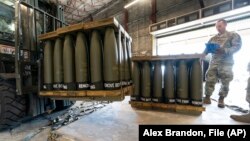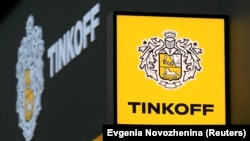
Welcome to Wider Europe, RFE/RL's newsletter focusing on the key issues concerning the European Union, NATO, and other institutions and their relationships with the Western Balkans and Europe's Eastern neighborhoods. To subscribe, click here.
I'm RFE/RL Europe Editor Rikard Jozwiak, and this week I'm drilling down on two major issues: How both the EU and NATO are scrambling to get more ammunition to Ukraine and how justice might be served after the war has ended.
Brief #1: Getting Ammunition To Ukraine -- And Replenishing Western Stocks
What You Need To Know: Perhaps the most pressing issue for both the European Union and NATO in relation to the war in Ukraine right now is ammunition. First and foremost, how to supply Kyiv, especially after President Volodymyr Zelenskiy during his visit to Brussels earlier this month warned about the latest Russian offensive and the urgent need for more military deliveries.
Ukrainian Defense Minister Oleksiy Reznikov also recently specified to Western colleagues the need to get 1 million rounds of 155-millimeter ammunition urgently.
At the same time, there is also a need to replenish Western stockpiles, which are depleting quickly. Quite how fast remains classified; no one I have spoken to is willing to share, but they can confirm that, apart from the ammunition Ukraine is asking for, there is also a shortage of HIMARS missiles and ammunition for air-defense systems. And this has forced Brussels into action.
EU defense and foreign ministers will discuss the issue when they convene in Stockholm on March 7-8. By then, EU foreign policy chief Josep Borrell will come up with concrete proposals on how to scale up production both for Ukraine and domestic stockpiles that potentially can be green-lighted when EU leaders meet in Brussels at the end of March.
Deep Background: In a letter to EU capitals sent last week and seen by RFE/RL, Borrell noted with urgency that “the future of Ukraine is at stake. We have committed to standing by Ukraine as much as needed. There is no time to waste.”
He proposes utilizing the European Peace Facility (EPF), a financial tool used by EU member states outside the regular EU budget that has been tapped into to the tune of 3.6 billion euros ($3.8 billion) so far for arms deliveries to Kyiv. Another 2 billion euros ($2.1 billion) is available, but the question is: Is that enough? In a discussion paper produced by Estonia on the issue, it is noted that Russia’s average artillery use is 20,000-60,000 shells per day.
That means that Russia fires Europe's monthly artillery production rate (currently estimated at 20,000-25,000 shells per month) in a single day in Ukraine.
What is needed, according to Tallinn, is a sevenfold increase of European defense industry production -- to the tune of 4 billion euros ($4.2 billion) -- to meet Reznikov’s demand in six months. Otherwise, it will take a full four years to produce the 1 million rounds asked for.
Drilling Down
- Two of the main issues here are coordination and, by extension, joint procurement. NATO has already been doing this for years, but the EU will explore this as well, with the likely caveat that production must be in Europe. One of the main hurdles to overcome is that defense issues remain an exclusive competence of each and every EU capital, making it trickier to reach any sort of consensus.
- NATO has also agreed to help Ukraine develop a smoother procurement system in line with Western demands. But more importantly, the EU, NATO, and Ukraine have started comparing notes on the issue. NATO Secretary-General Jens Stoltenberg, Ukrainian Foreign Minister Dmytro Kuleba, and Borrell met in Brussels last week and agreed that their respective procurement experts will put their heads together in the coming days.
- When asked why it had taken nearly a year for this to happen, Kuleba responded that “no one expected this war would last this long” and added that it was apparent already last summer that production needed to be ramped up but that “not enough has been done.”
- NATO officials admit privately that stockpiles were pretty low even before the war, largely because no one really foresaw a large-scale war on the continent again. They also note that much of the weapons production in the West has become very specific -- even “artisanal” -- instead of focusing on the big bulks of ammunition that are now clearly in demand.
- What is needed now is a clear signal of demand from government to industry. This usually means long-term contracts, something that an increase in NATO’s target for ammunition stockpiles could trigger.
- But there are bottlenecks -- and not only bureaucratic red tape. And many of them are felt in many other industries around the globe. The worldwide shortage of semiconductors is one, but also the lack of raw materials to make ammunition shells, for example.
- One quick-term fix will be to simply reach out to international partners, with Brazil, Israel, and South Korea being singled out as having deeper stockpiles at the moment.
Brief #2: Justice for Ukraine: Will Russian Officials Ever Face Trials?
What You Need To Know: One of the big issues surrounding the war in Ukraine is the question of justice and how it can be served once the fighting subsides. Ukrainian authorities have registered more than 71,000 alleged war crimes committed by the Russian Army since the war broke out -- a number that is likely to grow both as more Ukrainian territories potentially are liberated and the war intensifies.
Ukrainian and international prosecutors, however, are already busy collecting evidence, with the International Criminal Court (ICC) playing a lead role, having set up a so-called Joint Investigation Team with over 20 countries, mainly EU member states, assisting with various investigations.
An international center for the prosecution of the crime of aggression against Ukraine is also being established in The Hague this spring in cooperation with the ICC and Eurojust -- the European Union agency responsible for criminal justice cooperation -- housing a judicial database of all available evidence. The big question, however, is: Which court will all of this work eventually end up in?
Deep Background: The most obvious answer should be a court under the auspices of the United Nations. That route, however, is complicated by the fact that Russia is a permanent -- and thus veto-wielding -- member of the UN’s Security Council.
This also complicates potential efforts to render justice via the ICC. Moscow did sign the Rome Statute, which governs the ICC, back in 2000, but never ratified the agreement to become a member. Russian President Vladimir Putin then approved the withdrawal of his country from the process of joining when the ICC ruled in 2016 that Russia’s actions in Crimea amounted to an "ongoing occupation."
The ICC can, however, still prosecute genocide, war crimes, and crimes against humanity committed on the territory of Ukraine because Kyiv submitted to its jurisdiction.
What the ICC cannot do is investigate and prosecute crimes of aggression committed by Russian nationals in Ukraine, as Russia is not a party to the ICC.
And the crime of aggression is crucial here.
The countries leading the process of justice for war crimes in Ukraine consider the crime of aggression to be the “supreme international crime” and the "source of all the other crimes committed in the country." It also limits criminal responsibility to individuals in leadership positions.
The conundrum is how to get these people in the dock. They all enjoy international immunity and could easily hide in countries that do not recognize the ICC’s jurisdiction. Trials in absentia could, of course, be held even if they tend to be regarded as “imperfect,” especially by victims.
Drilling Down
- With the ICC option unlikely, there could be a case of having trials in Ukraine, including at locations where Russian atrocities are alleged to have been committed. While perhaps morally satisfying, there is, of course, the same doubt as to whether Russian officials would be present at such trials, and it could be argued that the proceedings would not enjoy widespread international recognition.
- Hybrid courts, consisting of both international and Ukrainian prosecutors, could be another option, but the presence of Ukrainian nationals in decisive positions could be an issue for many nations that would prefer a more neutral setup.
- Instead, the option that is most likely to fly is the establishment of a special tribunal for the crime of aggression created through an agreement between Ukraine and the United Nations, but circumventing the UN Security Council and instead relying on the UN General Assembly (UNGA).
- No specific number of votes is needed for this to happen, but EU officials I have spoken to on condition of anonymity say they could push for it “as soon as it is clear there is enough support” and that this might happen at the UNGA in September, when many world leaders gather in New York.
- A special tribunal set up under the UNGA could potentially also solve the issue of lifting the immunity of high-ranking politicians. Such privileges, according to international law, don’t represent a roadblock to the prosecution of senior leaders for serious crimes before international criminal courts and tribunals acting on behalf of the international community.
- Can a court set up via a UNGA resolution truly represent the international community as a whole? That would probably be a question open to various legal and political interpretations, and it could ultimately come down to how many nations in the UN eventually vote in favor of such a court. One thing, however, is clear: There is no statute of limitation on crimes of aggression, so the international community can opt to play the "long game" in the quest for justice.
- It is also worth noting that there is a precedent for the UNGA setting up a court. The Extraordinary Chambers in the Courts of Cambodia, commonly known as the “Khmer Rouge Tribunal,” was established in 1997 after a UNGA resolution. It is worth noting, however, that it didn’t prosecute crimes of aggression.
- There is, of course, also the opportunity for both individuals and states to opt for civil lawsuits. The most obvious avenue here could be the European Court of Human Rights (ECHR). But, after its exclusion from the Council of Europe last year, Russia ceased to be party to the European Convention on Human Rights on September 16, 2022. This limits applications against Russia and Russians to crimes committed up until that date.
Looking Ahead
The leaders of Kosovo and Serbia will come to Brussels on February 27 for their first meeting under the EU-facilitated dialogue this year. And there are indications that they might agree to a deal to further normalize bilateral relations.
There seems to be some movement on the NATO enlargement front after a number of recent setbacks. Finland’s parliament will vote on its NATO membership bill on February 28, and the Swedish government has indicated that it will follow suit in early March. Hungary’s parliament might soon ratify the Nordic pair’s accession treaty, and even Turkey has opened up for more talks with Helsinki and Stockholm in order to give its thumbs-up to let them join the military alliance.
That's all for this week. Feel free to reach out to me on any of these issues on Twitter @RikardJozwiak or on e-mail at jozwiakr@rferl.org.
Until next time,
Rikard Jozwiak
If you enjoyed this briefing and don't want to miss the next edition, subscribe here. It will be sent to your inbox every Monday.
And you can always reach us at newsletters@rferl.org.





